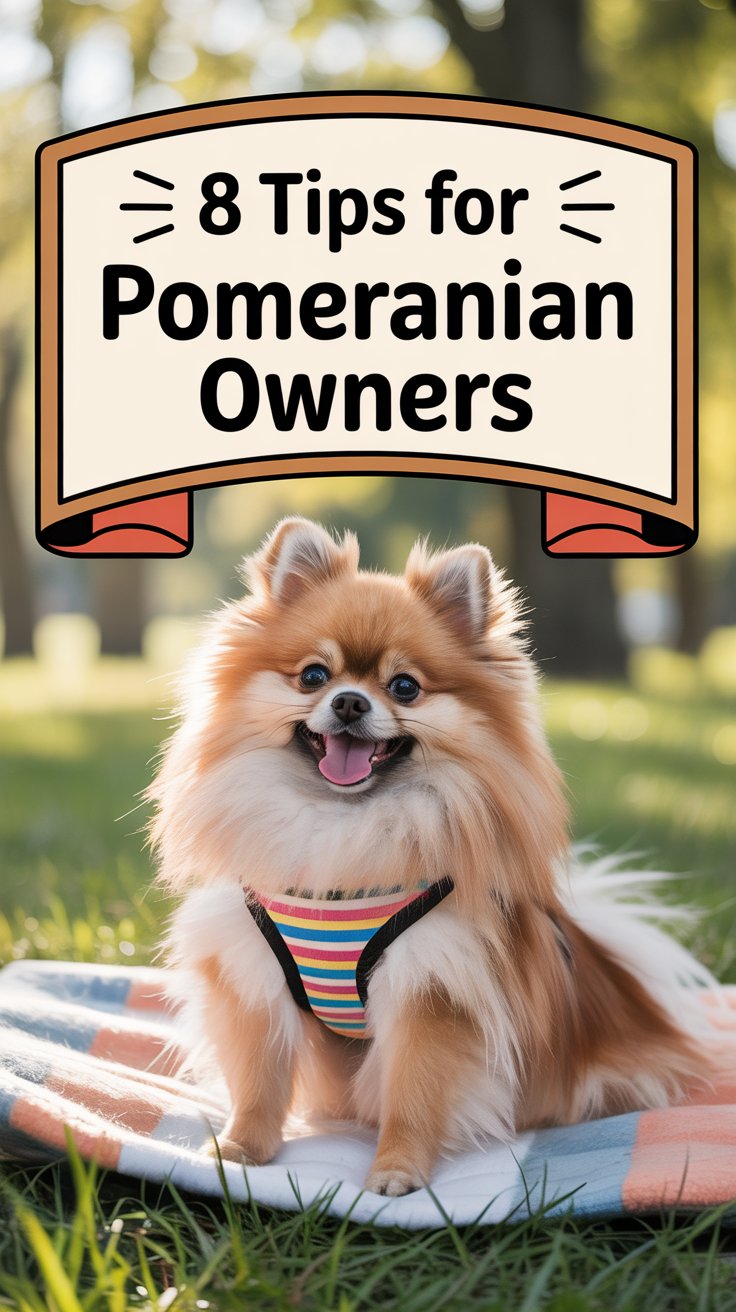By David | March 12, 2025
So, you’re thinking about bringing home a Pomeranian? Congratulations! These tiny fluff balls are packed with intelligence, charm, and a whole lot of sass. But before you get swept away by their cuteness, it’s worth knowing that Poms aren’t just lap accessories — they’re bold, smart, and full of character.
If you’re prepared, a Pom can be a loving, loyal, and well-mannered companion. If not? You might end up with a tiny tyrant that rules your house!
Here are 8 Must-Know Tips — with advanced insights — for anyone planning to welcome a Pomeranian into their life.
🐶 1. Training Is NOT Optional (Even if They Weigh 5 Pounds)
Pomeranians have big-dog attitudes packed into tiny bodies. Without early training, that fiery personality can quickly spiral out of control.
- Start Training Early: Begin with basic commands like “sit,” “stay,” and “quiet” from day one.
- Reward Frequently: Poms respond best to positive reinforcement (treats, praise, and play).
- Set Boundaries: Don’t excuse bad behavior just because they’re small — a 5‑pound dog barking endlessly is still a problem.
✅ Pro Tip: Establish a strong recall command. It can save their life, especially if your Pom doesn’t recognize their tiny size.
🐕 2. Socialization Is Critical (or They Will Try to Rule Everyone)
Poms are confident and protective, but that can turn into aggression or fear if they’re not properly socialized.
- Introduce them to a variety of people, dogs, and environments.
- Let them experience sights, sounds, and surfaces (car rides, vacuums, elevators).
- Arrange supervised playdates early.
💡 Fun Fact: A Pom will challenge a dog ten times its size — be their voice of reason and protect them from their own bravado.
✂️ 3. Grooming Is a Lifestyle (Fluff Comes At a Price)
Poms have a beautiful double coat that needs attention, or it will quickly become a tangled mess.
- Brush daily (or every other day) to prevent matting and remove dead fur.
- Bathe every 3–4 weeks, and use a dog-safe conditioner.
- Trim nails every 2–3 weeks and clean their ears regularly.
- Watch out for the “puppy uglies” phase (around 4–6 months), when their coat may thin temporarily.
Advanced Tip: Consider learning basic scissor or clipper grooming at home — this can save money and reduce trips to the groomer.
🐾 4. They Are Velcro Dogs (Say Goodbye to Personal Space)
Poms thrive on being close to their people. Left alone too long, they can develop separation anxiety.
- Gradually train them to tolerate being alone (start with short intervals).
- Provide interactive toys and safe spaces when you’re away.
- Consider a second pet or doggy daycare for longer absences.
Reality Check: If you work long hours, be prepared to adjust your routine or hire a pet sitter.
⚡ 5. Exercise Is Non-Negotiable (Even Small Dogs Need to Move)
While tiny, Poms have surprising energy and can quickly become bored and destructive if not properly exercised.
- Aim for 30–45 minutes of activity daily (walks, fetch, training games).
- Incorporate mental exercises like interactive toys or obedience practice.
- Avoid over-exercising puppies — their growing joints are delicate.
The takeaway: A tired Pom is a happy Pom. A bored Pom is a barking, chewing tornado.
🗣️ 6. Barking Will Be Your Soundtrack (Train Against It!)
Poms love to “protect” their territory, which can mean barking at every sound.
- Teach the “quiet” command early. Reward when they stop barking.
- Identify barking triggers (doorbell, neighbors, wildlife) and desensitize your Pom to them.
- Incorporate more mental enrichment and physical activity to reduce boredom barking.
Reality Check: An untrained Pom can turn your home into a constant yapping zone.
🧠 7. They Are Brilliant (Use It to Your Advantage!)
Poms are highly intelligent and pick up new tricks quickly.
- Invest in obedience classes and advanced training courses.
- Teach fun commands (high five, spin, play dead).
- Use puzzle toys and interactive games to keep their sharp brains engaged.
✅ Advanced Tip: Try agility or rally obedience for an amazing bonding experience and an outlet for their energy.
💪 8. Treat Them Like a Dog, Not a Toy
It’s tempting to carry a Pom everywhere, but remember — they’re still a dog.
- Let them walk and explore to build confidence.
- Socialize them properly so they don’t develop “small dog syndrome” (overreacting out of fear).
- Maintain rules and boundaries as you would for a larger breed.
Final Thought: Treating your Pom like a “real dog” sets the foundation for a balanced, confident, and well-behaved companion.
👇 Bonus: Health and Wellness Must-Knows
Pomeranians are prone to certain medical conditions. Stay ahead with regular veterinary care:
- Dental Health: Brush their teeth 2–3 times per week (daily if possible), as Poms are prone to dental disease.
- Joint Health: Watch out for luxating patellas (dislocating knees). Maintain a healthy weight and use ramps if needed.
- Tracheal Collapse: Use a harness, not a collar, for walks to protect their delicate trachea.
- Regular Checkups: Annual vet visits are crucial for early detection of heart disease, hypothyroidism, and other common Pom illnesses.
✅ Final Thoughts
Owning a Pomeranian is an adventure filled with fluff, fun, and a lot of sass. These tiny dogs have huge personalities — and with the right training, socialization, and care, you’ll have a loyal, loving companion for many years.
If you’re ready for daily brushing, constant companionship, a little barking, and endless affection, a Pom might just be your perfect match.
Your future fluff overlord is waiting. Are you ready? 🐾
